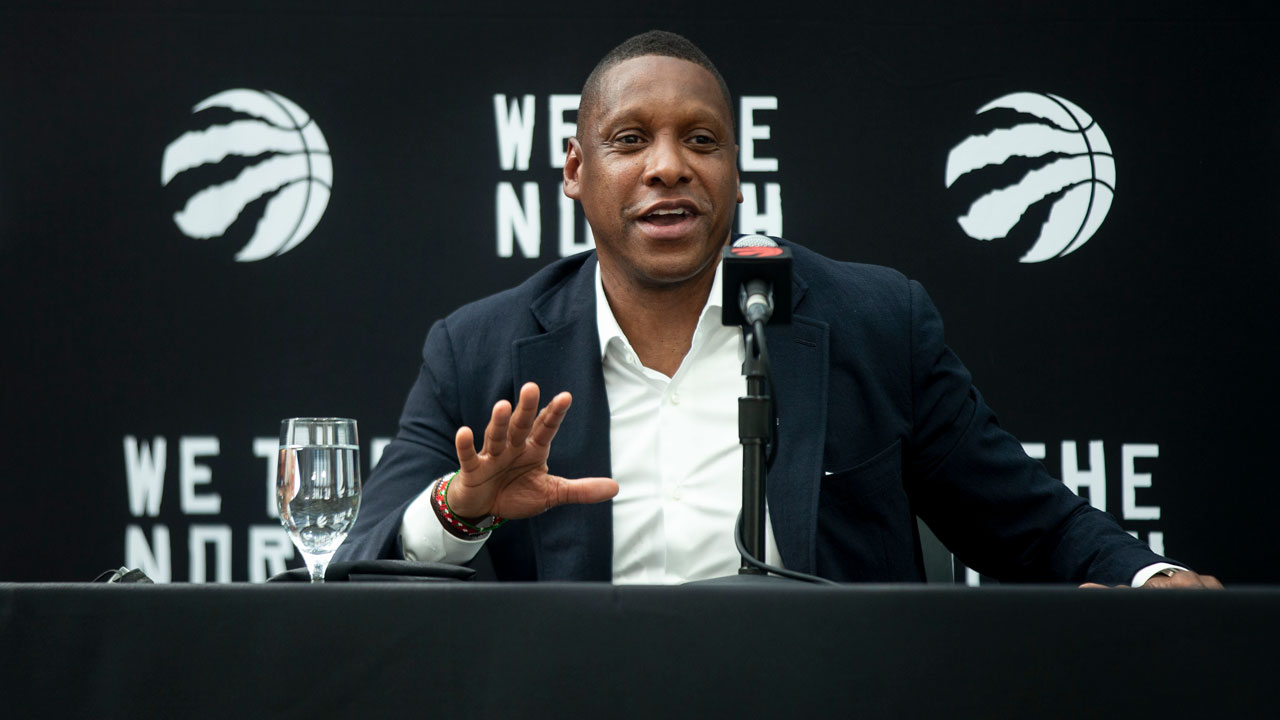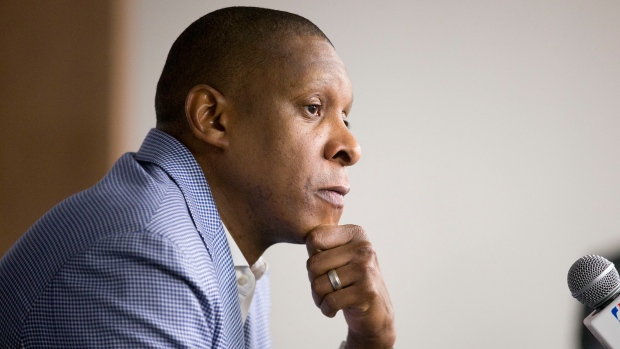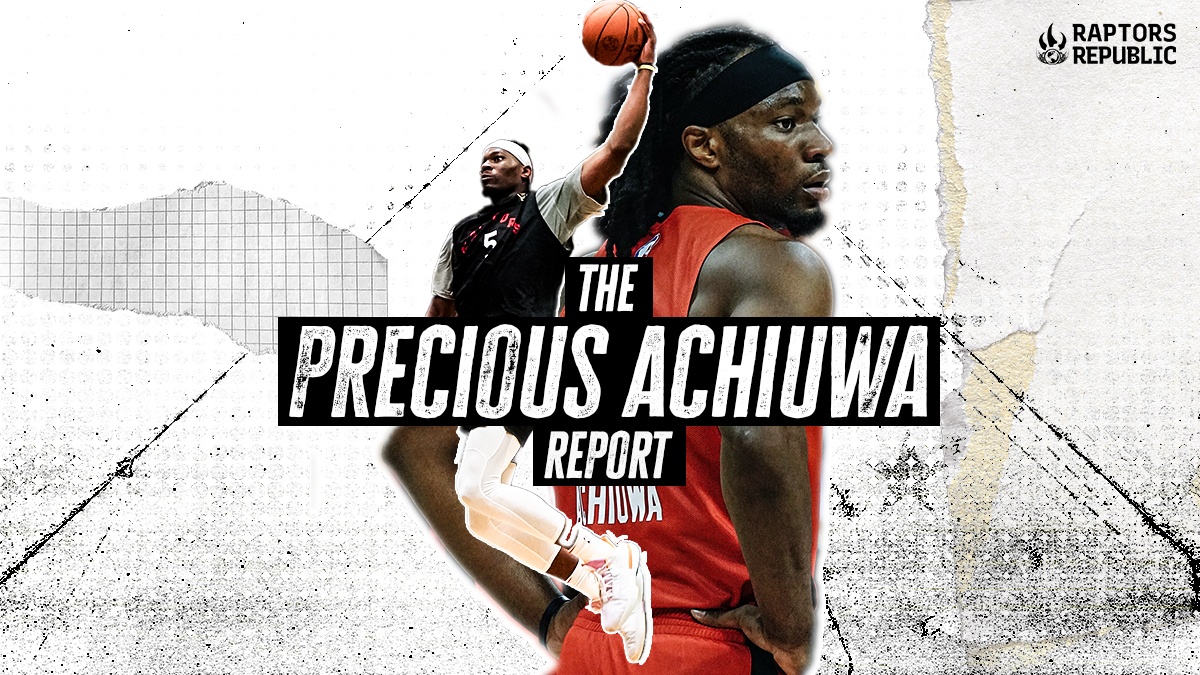When Masai Ujiri speaks, you listen.
The newly signed Vice Chairman and President of the Toronto Raptors spoke to the media in-person on Wednesday afternoon live from Toronto for the first time since the start of the pandemic. He was in his colloquial bag, dropping gems about wrestling MLSE chairman Larry Tanenbaum in a room for two months straight while negotiating his contract, telling Precious Achiuwa “you’re mine now” once the ex-Giants of Africa camper landed in Toronto, professing Lowry is the greatest Raptor of all time, and saying “it’s incredible” how teams always have deals done just two minutes after free agency begins, all with a smile on his face.
But more than being his usual confident and optimistic self, Ujiri spoke about a new vision for the Toronto Raptors; a way for the franchise to blaze a trail on the court and off of it.
Ujiri spoke about the importance of the team returning to Toronto this season (he seems confident that they will), claiming that the displaced season in Tampa Bay cost the franchise two years of progress, and that another displaced season would cost them five years. He was excited about the potential opportunities that the growing metropolitan of Toronto provides, and spoke about how players haven’t even “scratched the surface” in the ways they could attack the world with Toronto as a home base.
Ujiri focused on the need to develop young players, saying that the Raptors would not be a superteam with multiple superstars coming through free agency and would instead win by drafting and developing young talent, believing that “all these players we think have a level to go (up)” in the development curve.
But maybe most important for fans watching from home, wanting desperately to know what the Raptors are going to resemble on the court after a tumultuous season in which they struggled on both ends of the floor and finished with a 27-45 record — twelfth in the Eastern Conference, missing the playoffs for the first time since 2013 —Ujiri provided insight into his team-building philosophy and about how future iterations of the Raptors will likely look.
“One day, we want to play big and long,” Ujiri said about his vision for the Raptors, a team that drafted three big ball-handlers in the 2021 NBA draft and who enter the season with a roster sporting 11 players 6-foot-8 or taller. “We’re going to create our own direction. We don’t have to move in the way the league is moving. The NBA is such a copy-cat league.” The Raptors want to blaze their own trail.
Masai Ujiri talks about the current make-up of the Raps and how they will proceed moving forward. pic.twitter.com/9IFQm17VCO
— TSN (@TSN_Sports) August 18, 2021
In a league that values “pace and space” — the ability to play fast while spacing the floor with multiple three-point shooters — while trending towards valuing offensive creators over defense ones, the Raptors are going in a different direction. Rather than targeting young players with highly developed offensive skills or event creation — the ability to create advantageous opportunities on the floor for you and your teammates — the Raptors are looking for big, lengthy, athletic players who move well and excel on the defensive end of the floor. Call it “length and strength,” if you will.
That’s part of the reason the Raptors drafted 6-foot-8 forward Scottie Barnes, 6-foot-9 Canadian point guard Dalano Banton, and 6-foot-3 combo-guard David Johnson in the 2021 NBA Draft instead of targeting offensive initiators like Jalen Suggs or Shariffe Cooper, and it’s why Ujiri plucked Nigerian center Precious Achiuwa out of Miami rather than Tyler Herro as part of the Kyle Lowry sign-and-trade. That defensive prowess and versatility is also part of the reason the Raptors value Pascal Siakam and OG Anunoby so highly, why they recently signed Chris Boucher and Khem Birch to multi-year deals, and even why they are bringing Sam Dekker and Isaac Bonga to training camp. Even Fred VanVleet, a 6-foot-0 point guard with short arms, fits the Raptors’ mold as a defensive-minded player who is elite and ripping the ball away from players and smart enough to rotate on a string with his teammates.
Simply put, the Raptors still believe defense wins championships. In a league trending in the opposite direction — especially with superteams like the Brooklyn Nets and to a lesser extent the Los Angeles Lakers with Russell Westbrook — the Raptors hope to follow their own path. And there are lessons to take from past Raptors’ teams that could provide insight into which way this roster is trending and how this team is going to try to play on both ends of the floor.
As Ujiri and head coach Nick Nurse have repeatedly made clear: defense is the priority. When Nurse was asked to expand upon that sentiment recently, he mentioned that the NBA Champion Milwaukee Bucks ultimately had the best defense in the league last season. That means the Raptors will need to improve on their 19th ranked defense from last season and move towards the 2nd, 5th, and 5th ranked defenses from the three seasons prior if they want to be competitive. That won’t be easy, as the Raptors have lost key defensive contributors in recent years including Lowry, Serge Ibaka, Marc Gasol, Kawhi Leonard, and Danny Green. They have replaced them with big, defensive-minded players, yes, but young ones who are yet to prove themselves at the NBA level and who will likely need time to adjust to the speed and physicality of NBA basketball, not to mention Nurse’s sophisticated and unique defensive system.
The other area where the Raptors need to improve in order to reach their potential is in transition, an area the Raptors will rely on to fuel their offense next season. After getting defensive rebounds and forcing turnovers, the Raptors will want to run and score efficiently against unset defences, partly because they have the tools to do so and because they don’t project to be very good in the half-court. Unfortunately, the Raptors struggled in transition last season, scoring just 1.12 points per possession in transition, 12th worst in the NBA. But a ton of their offense still came on the break, and the players got better at playing at the speed Nurse expects from them as the season went along, with Siakam in particular getting much better at making plays for his teammates on the run. Add Scottie Barnes into the mix next year and they project to be really hard to stop in transition, with multiple big, fast ball handlers with passing chops and skill to finish around the rim.
But when Ujiri speaks about playing one day playing “big and long,” he isn’t referring to slow 7-footers lumbering up and down the court. In fact, the team currently has zero players listed at 6-foot-10 or taller. Instead, Ujiri is likely referring to what people in NBA circles might actually call “small ball,” because even with Khem Birch and Precious Achiuwa manning the center spots, the Raptors are relatively small at that position and will instead rely on multiple wing-sized players who are smart, quick, lengthy, and strong enough to guard multiple positions.
They will also likely play without either of those centers for long stretches, if not this season, then down the line in a playoff series in order to maximize their spacing. It’s likely that the Raptors noticed something in the small-ball lineup that dominated stretches of the 2020-21 season, with Lowry-VanVleet-Powell-Anunoby-Siakam zipping around the court and wreaking havoc on both ends, outscoring opponents by 14.0 points per 100 possessions. With Barnes and Banton now in tow, the Raptors are building a team that can potentially have three or four Anunoby/Siakam types on the floor at a time who can each guard multiple positions and cover a ton of ground while still rebounding, negating the need for a traditional center and essentially taking “small ball” to its extreme.
The Raptors have exploited market inefficiencies ever since Masai Ujiri took over in 2013. Most recently, it involved drafting older players that other teams passed up on. Now, it involves targeting versatile wing-sized players who can handle the ball, create for others, and defend across positions even if their offensive skills lag behind. They seem to believe that this is the path to success, and at least until the rest of the league catches on, it might be.
“We want to win in Toronto,” Masai said repeatedly throughout his press conference. “All that stuff is from the past. We can celebrate and be cool about the past. [But] the NBA is now. We’re building for the future.”
“In some ways there’s unfinished business.”



